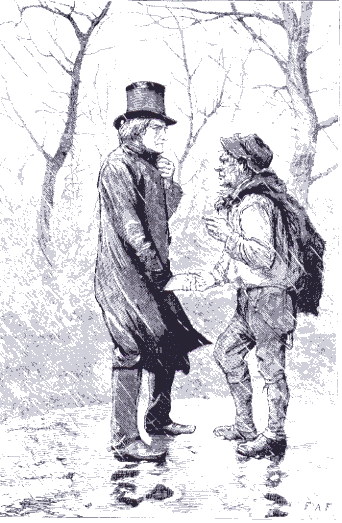This is appropriate as we are told that it was Mr Fletcher, the butcher, who first became angry when he heard other tradesmen has been paid before him and wrote Bishop Proudie repeated letters complaining harshly about people who don't pay their bills. The male figure is hard-looking, determined, no gentleman.
George Housman Thomas has carefully studied Millais's depiction of Rev and Mrs Crawley as they first appeared in Framley Parsonage, and given us the same originally graceful dignified pair. The woman has not changed much, just older, somewhat heavier; the man looks sunken-in, brooding, slightly deranged. He looks at some space in the mid-range of the room; his hand clasp his head and knee. The room is bare: a wooden talbe, a book, a cupboard, books on a writing desk nearby.
The emphasis is on two girl who are drawn as at the front with Mr Crawley facing away from us and towards the others. He is talking to and controlling the children patiently. The girls whispering to one another; we distinguish benches. The lack of hair-styling and gowns of the children mark them as working-class. This is how this man spends part of his day.
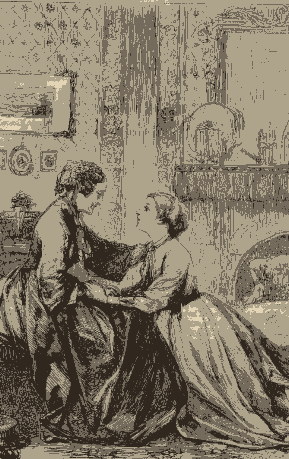
This is a picture of a fairly young woman (she could be no more than 20) as suppliant on her knees to kindly older woman. The room is exquisitely detailed, from the elegant wallpapers, to the pictures on the wall, flowers on furnitue, a mantelpiece with fringe, a mirror, pillows scattered about, and the two women's dresses, hair. Hall praises Thomas for having created pictures 'reminiscent of Millais; they are, however, much less idyllic and more alert, older, as delicate, but worried.
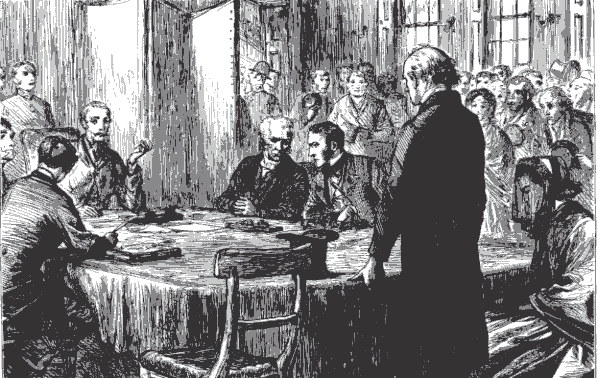
This is a superb picture; this is a close imitation of the man we saw in Millais in 'The Crawley Family', except now, as Trollope said of Millais's picture of Lady Mason early in Orley Farm (see Annotated Commentary 1, 'There was sorrow in her heart, and deep thought in her mind') Mr Crawley is bending to try to find within himself 'in spite of all that [he] had gone through . . . .more of strength, -- more of the power to resist all that this world could do to [him]. Housman has posed Crawley as he was in the near-by picture of himself with the respectful children; now his audience is indifferent or hard and well-dressed, with authority over him He is tired and stiff; Mrs Crawley sits veiled at his side. The two men at the side of the table and in the center of the picture space are finely detialed, grim, whispering. Hall writes that the 'entire crowded scene has movement and tension'.
The depiction is expressive rather than realistic: the psychology on the face of Mrs Proudie is exaggerated: she is pig-like rather than pugnacious, supercilious to the point of absurd sniffing. However, this is what she feels like to the reader: the worst of self-righteous blind bullies. The Bishop is in shadows, holding his hands still. Again the room is exquistely detailed; it is well-appointed with curtains, rugs, handsome table, books.
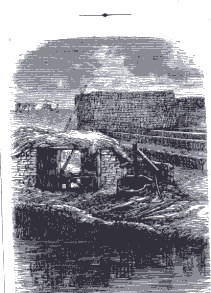
This tiny vignette ought to be better known. It might help offset the common idea that Trollope's books are almost wholly about the rich and upper class. We see a realistic depiction of a brickshed, straw on top, tools inside, nearby a hard-worked well, a little farther off another frail-looking structure. A small wooden bridge crosses a stream; agricultural tools are stewn in the distance. This is the scene after the men have left a hard day's labour. It recalls water scenes in Dickens's novels with the difference that nothing melodramatic has or is about to occur. The sky is lowering but clear at the edges (through a light and heavy use of lines).

We see Mr Crawley sitting by the fire, warming himself, looking up to a working man who scratches his head. Crawley isn't too proud here. The wife is seen in shadows by the threshold and not carefully drawn; on the floor are straw baskets; on the table a teapot. The picture is placed precisely over the dialogue where Crawley asks Dan for advice and solace. The two are on Crawley's side, but don't know what to say or how to help. It looks forward to the picture later in the volume where Crawley again appeals to a working man and is told '"It's dogged as does it"' (the frontispiece for the 1878 8 volume set, see below). It is subtle, quieter.
Here we have the mature John Eames, handsome elegantly-dressed gentleman about town who has made a success of his profession. From the side we can see a young face; he is beardless, has only long whiskers.
We see an ostentatiously crest-fallen and submissive young woman who looks down at the floor in plaintive blankness as an older elegant gentlemen bows to her; they stand in front of a church, with a complacent older Lily to one side. It reveals how the Victorian reader saw and acceptd Grace Crawley's behavior and status as lowly and the Squire's as high and self- assured. (This reader hopes others gag as they look at this one too.) Grace contrasts strongly with the self-assured older aristocratic gentlemen in the vignette to Chapter Seven.
Here we have Rev Crawley braving the loss of respect he now must endure as he goes into his church. Not enough work has been done on the Crawley figure, but the working man who looks belligerently out from the left-corner of the picture is well done, as is the somewhat gentlemanly man who stands just back of him (in lighter lines) repeating the same attitude.
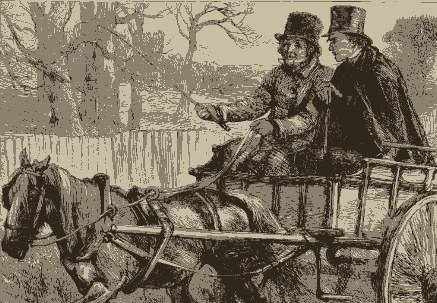
Another picture which ought to be better known. We see two large figures sitting together on a cart, all on the right side of the picture. To the back the landscape is wintry (bare trees, thin grasses) and the white makes it chill. The farmer has a pleasant sturdy expression on his face as he urges his horse on; he is well-bundled up, prosperous, good-humoured. Mr Crawley's outfit is elegant, but looks thin; his expression is glum, glowering, tired. The horse is beautifully drawn. Here is Mr Crawley taken to the Bishop's palace in comfort in despite of his aching pride.
Here is our old friend Mark Robarts come to ask Mr Walker's opinion (the dialogue faces the picture on the next page of the Harper edition). One can make out Mark's clerical collar; the room is small; Mr Walker who faces us, looks perturbed.
We see an old frail man sitting somewhat hesitantly on a couch as he looks down at a young female child, blonde. To the right standing behind them are an elegant gentlemen in his thirties and a much older one whose hair is gray and grizzled; a middle aged lady bows to the little girl while talking to her. This is Mr Harding, who is drawn far less sentimentally and absurdly than Millais's figure. He is simply frail; Dr Grantly has aged, is stout and looks a bit tired. Perhaps Mrs Grantly is made too young to be the mother of Major Grantly who now appears in a larger clearer drawing. Like Johnny Eames, he lacks a beard -- in fact almost no one has a beard in these drawings. The picture does not come off to this modern reader because the child is a fetish object; her face is actually far too adult and knowing, the eyes recalling those of glamour cartoons in 20th century magazines.
The scene is not dramatised in the text; instead we are given Adolphus Crosbie's letter to Lily's mother in which, now that his wife is dead, he attempts to begin a romance leading to marriage with Lily once again. The postman looks old and frail, not well-dressed; the maid has a cross expression on her face, but the latter may be just inadequate engraving. The effect is to emphasise the rural quiet world of Barset into which the letter arrives.
As Mizener writes we see 'Adolphus Crosbie stepping across the Dobbs Broghton's drawning-room to shake hands with Johnny Eames. On Johnny's right sits Madalina Desmoulines; next to her is Augustus Musselboro, and next to him Mrs Vansiever. the two (male) figures in the background are Mrs Broughton and Conway Dalrymple. My comment: there is an intendedly strong contrast with vignette of postman and maid; we see an elegant party going on, with richly dressed ladies and gentleman, the world Crosbie married to get into. As with Millais's depiction of 'Lady Lufton and the Duke of Omnium' for Framley Parsonage (see Annotated Commentary 1), the focus is on an older woman's face: this time, it's the avaricious, mean Mrs Van Siever, a measure of the difference in mood in this book's presentation of high life and that of Framley Parsonage). Pace Mizener's denigrating commentary, this picture is as effective in its way as Millais's: the woman in the center is the spirit of the place; Crosbie's outstretched hand is accompanied by a cold supercilious expression on his face; Madalina has an anxious, expectant and demanding look at she faces Johnny whose face is depicted looking away to Crosbie.
Just below in the American edition we read the following ironic passage:
'"I don't think you care two straws about her", Conway Dalrymple said to his friend John Eames, two days after the dinner party. The painter was at work in his study, and the private secretary from the Income- Tax Office, who was no doubt engaged on some special mission to the West End on the part of Sir Raffle Buffle [oh doubtless], was sitting on a lounging chair and smoking a cigar.
Considering the importance of the picture in the story, the choice is right from numbers of points of views. Alas, not enough time has been taken on the engraving, and the figure of Dalrymple is simply recognisable as artist from his beard, palette, and smock.

Mrs Dobbs-Broughton is very well drawn -- as Hall would say, much in Millais's manner. She is intently looking at the picture in which we can see the outlines of the Sisera- Jael story. She is proud, intelligent, beautifully dressed; Dalrymple backs away hesitantly. The problem with the picture is in Clara Van Siever's face: what is meant to be jealousy comes across as a distanced flat expression. The room is that of a wealthy woman, lovely lace curtains on the window; to the side on a pedestal, a naked woman kneeling, an arm drawn across her breast is the best touch (even if not sufficiently carefully engraved). Clara is dressed in an absurdly beribboned, bemuffed, belaced young way which is precisely appropriate to the means her mother has used to imprison her all her life thus far.
In shadows and not carefully engraved we see Major Grantly arriving in the yard of the Red Lion, preparatory to walking to Mrs Dale's house to see Grace.
This is a good landscape picture. We see the quiet Barsetshire countryside; the two gentleman are walking and conversing by a old thick tree; in the distance two women are walking in a pair (Grace and Lily). The Squire is bent over, intent; Major Grantly listening.
As Mr Toogood is a delightfully 'good' character, a moral touchstone in the story, it again shows Thomas took time over these pictures as this figure repeats the gestures, gait, whole appearance of Millais's first depiction of Mr Harding in The Small House at Allington. Compare Millais's '"There is Mr Harding comig out of the Deanery"' (see my Annotated Commentary 2); alas the ludicrous simper is then reproduced; this man has at least a hawklike vigilance rather than fraility to his body aspect.

This is a good one and deserves to be better known. We have a heavy-set rich-looking -- large imposing --Dr Grantly on a strong horse talking to the keeper who is clearly not intimidated but talks earnestly at him with his own dog at his feet. Grantly listens intently as the keeper tells him a word from him would go far to making the Ullathornes preserve foxes; the reference is to Grantly's desire to please and to make his son into a fox-hunting gentleman. Thomas has been careful to make Grantly consistent throughout.
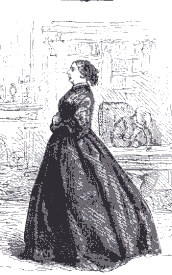
The background is poorly sketched; it is the same study we saw in '"A Convicted Thief"' above; and we see Mrs Proudie as a thrusting hard woman making the figure who covers his face with his hand in the background miserable.
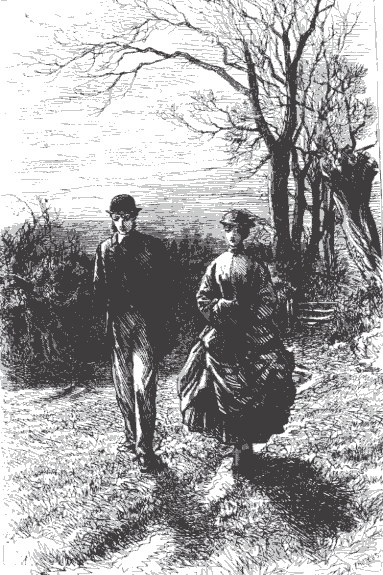
There is a closely similar picture in Henry Woods's series for The Vicar of Bullhampton, 'Sunday Morning at Dunripple' (see Annotated Commentary 6), an autumnal scene with Walter Marrable and Edith Brownlow walking side-by-side. Both pictures visualise quiet loss and stoic acceptance as the common experience of life touchingly. The delicacy of the intimation is conveyed by, as Hall says, the 'depersonalised faces', the stylisation, the 'sterile atmosphere' between two people walking in parallel lines at a distance amidst 'late afternoon shadows, leafless trees and, in the case of Thomas's picture, a huge stump. The same 'rigid upright posture' and quiet parallel walking apart is depicted in Thomas's and Woods's pair of people who will not become lovers, but could and maybe ought to have.
Grace looks sad to leave; beneath the picture is Mrs Crawley's letter to her daughter, asking her to come home to her father.


In the American edition on the other side of Mrs Crawley's letter we see Grace in a high collar (looking a bit older, probably because of the bun) and Lily (her dark hair is tied back) reading their respective letters while a full-bodied Mrs Dale reads a newspaper. A beautiful depiction with many details: the steaming tea, an open ham, a toast rack, bread and butter all laying on a cloth-covered table. An intimate scene of breakfast comforts, quiet sociability, which Grace must now leave.
Deep in shadows of a bare room, we see a young woman leaning on an older one; beyond a door threshold is a bed (Mr Crawley lies sick). A great deal of trouble has been taken over the full designed dresses, the thin drugget on the floor; the small round table with its cup of tea. Beneath it in the American edition we read the dialogue where Grace tells her mother of Major Grantly's visit and her proud response.
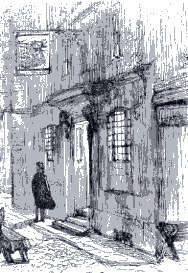
This is an effective vignette. The man seems so small, dwarfed, a mere dark shadow, against the large lit tavern detailed enough to show us the many-panelled windows, stairwell in to where there are bright lights (all white) against the shadowy silent cobbled streets.
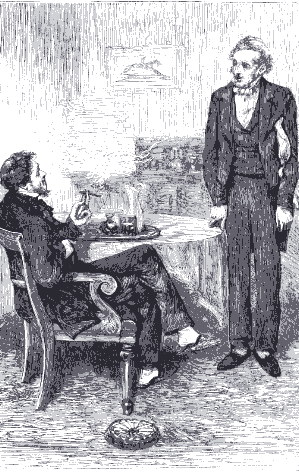
Wonderful picture, another of the best of the original illustrations to Trollope's novels. It is filled with good feeling emanating from the faces of the two men: the waiter is very old, his face very wrinkled as he stands at attention. It is a real face alive with alertness, consciousness. He is not glamorised; his outfit is wrinkled (like his face), a bit shabby, with thin slippers, one of his hands on the table between himself and his customer, Mr Toogood. Mr Toogood leans back in his chair, comfortably holding a smoking cigar as he looks up respectfully and genially at the waiter; they are talking. Mr Toogood has a liquor set-up on the table, is wearing flapping slippers. The lines are all carefully done to indicate the different objects in such a room (picture of a man hunting on the wall), back nondescript piece of wooden furniture.
The man looking up from his desk has a stubborn, unfriendly grimace on his face; the other is reaching into his jacket for a paper. Here is Crosbie borrowing money from Butterwell; in the American edition, the dialogue appears just below the vignette.

Lily is wearing the same striped dress we saw in an earlier illustration; it has good feeling emanating from the old man's face: he leans over the table watching Lily looking at a picture of Emily Dunstable who will now become Bernard Dale's wife. It recalls the women at the breakfast table of No. 14 (above). This novel is filled with good domestic pictures, and was read as a deeply-felt reflection of the life of the middle class at the time.
As can be seen from the passage just below, here is Bishop Proudie struggling with the difficult task of writing to Mr Tempest to ask him to come to the palace to set another investigation on foot which neither he nor Dr Tempest want. The figure looks unusually light and intelligent; probably the result of Mrs Proudie not being in it to cow the man. We are told in the chapter that the Bishop was good at writing such letters and this to Mr Tempest was and is effective in just the way the Bishop wants.
A well-drawn, elaborated picture of John Eames walking along with Mr Toogood at his side. Mr Toogood looks very concerned; Johnny holds his head down; has a heavy cloak on one arm and round rather than top hat. We see a train next to them, and shadowy people at work on top of it loading the luggage onto the train. John is going off on his chivalrous mission to save Mr Crawley; he is ever troubled by his desire for Lily and betrayal of her with Madalina.
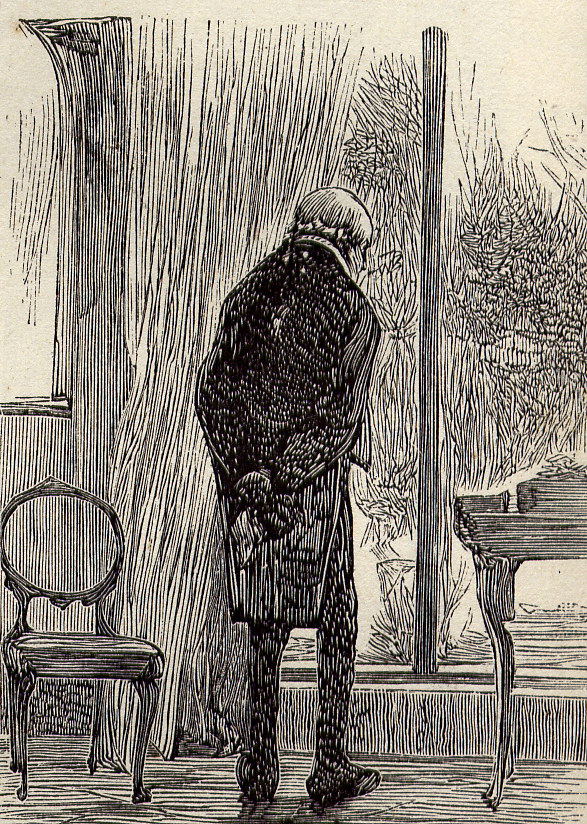
From the verbal context this ought to be Dr Grantly thinking about the bitterness he is going to cause if he carries on the quarrel with his son over marrying Grace Crawley. It would be a rare depiction of Dr Grantly in a yielding mood, it matches the picture of him talking to the keeper about foxes for hunting early in the book (see '"Never mind, Mr Henry"' above). However, the figure is dressed like Bishop Proudie and looks like him. Thomas is consistent in his visualizations; thus I think it is probably a depiction of Bishop Proudie after his wife's death (which occurs later in the novel) which has been misplaced.
This really an appalling picture; the child actually has a come-hither look on her preternaturally alert face; the old man clearly dotes on her. Lavish attention has been paid to details of the child's full dress, hair and shoes; a picture on the wall depicts a wealthy bourgeois woman overlooking another child. Chacun a son goût.
Clara is recognisably the same young girl we saw dressed up in frilly 19th century garb; here she is dressed for her sexy Biblical role, with Mrs Dobbs-Broughton (in the same dress she appeared in the earlier illustration), fixing the scarf which is to be wrapped round Clara's head. We see Dalrymple from the back looking back from a canvas to watch them. Clara's face is again not well done; it's as if Thomas didn't know what expression to give her. Mrs Dobbs- Broughton is again intent on her task, alive with intensity.
Another of Grace Crawley submissive, plaintively looking down, all shame and self- abnegation; she stands before Major Grantly and a comfortable looking Mrs Robarts (lovely shawl). He at least looks appalled. There is again something about the delineation of the face (its shape and expression) which recalls that of Celia Johnson (see Annotated Commentary 3 on the depiction of Florence Burton, 'Florence Burton Makes Up a Packet', an illustration by Edwards for The Claverings).
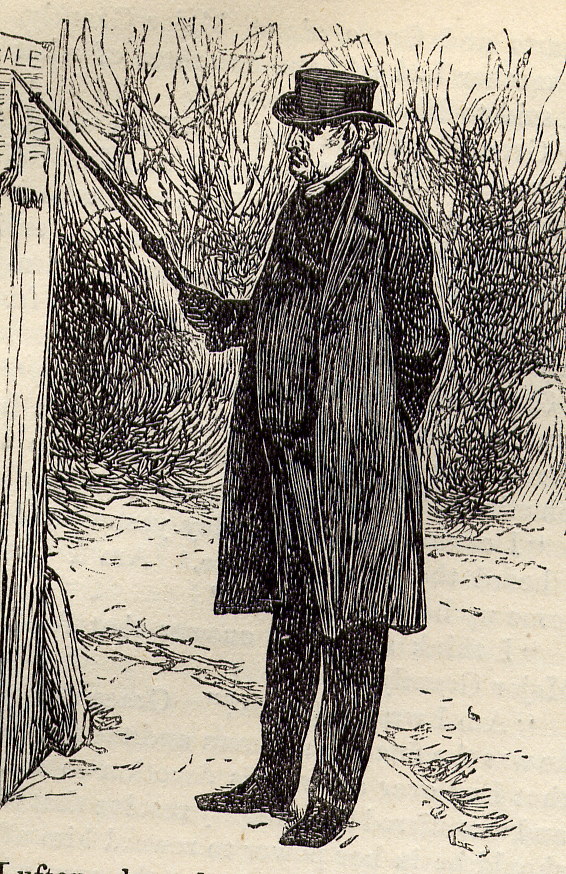
A wonderful vignette of Dr Grantly; perhaps it's the gingerliness with which he touches the sign he finds so awful that makes it exquisitely right for how this character would look were his son publicly to sell his property to others as things he cannot afford to keep or give away.
The same Dr Grantly we saw in the illustration of Posy and her grandfather looks down fondly at the uncomfortable young woman who cannot meet his eyes. He holds her hand in his wtih concern. Thus do we see Dr Grantly coming to accept Grace Crawley. He is made pretty in the picture; her face has more sharpness and wit in it than in the others.
A rare deathbed scene in the Trollope illustrations (there is another in Phineas Redux, see Annotated Commentary 7, '"He may soften her heart"'). My comment: Johnny is the elegant gentleman we have seen all along; Mr Harding's face is that of a death's head. The scene does not embody anything in the text so much as the 'meaning' of Mr Harding's death: don't do anything to someone in life which you will regret after the individual has died and it is too late to make amends; this is the moral of many of the ghost stories of the period.
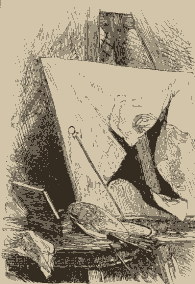
I like it; it says what happened concisely. The tear is a harsh black triangle against a canvas where we see a flailing fist held up.
This one has been superceded by Francis Arthur Fraser's much more graceful austere pair of men which became one of six frontispieces for the 1878 8 volume edition of Barsetshire Chronicles (see below). In this picture Hoggett the brickmaker is a rougher man, with a wide girth to the upper part of his body; he has no grace or elegance of any kind; his legs are thin and bent, his boots worn and clumsy. He points downward with one hand (for emphasis) and grasps Mr Crawley's hand with the other. Mr Crawley holds his coat tight shut against a feel of wind in the picture; it is also a wet day (seen in the grasses, lines on the ground and leafless large tree behind them. This is a good illustration; Hoggett is alive with feeling as is the landscape around them (Mr Crawley is slightly more cartoon-like). It ought to be better-known, and certainly along with the breakfast table, and the vignettes of Barsetshire ordinary life, one of those reprinted in modern editions of The Last Chronicle.
We see an elegant man who has something of a sycophantic or submissive posture returning to a sad-looking horse tethered to a fence; his hand is held out towards those in the house as if in explanation. Mr Thumble is stiff, uncomfortable. At the threshold we see a head we recognise as Crawley's; the young man next to him with the moustache is Major Grantly. We can see the worn cottage wall, a rough garden. This is an effective illustration of the moment after the scene we are about to read.
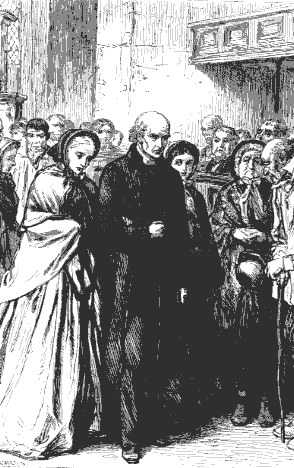
A moving depiction of Mr Crawley's final humiliation as he walks into court with Grace on his arm; the Millais-like grace and elegance Thomas has chosen for the scene fits, so too (pace Hall) the rugged head. Mr Crawley's head is now skull-like; the dark colours with which his clothes are filled in contrast with Grace's white dress and its heavy lines for folds. Yes people will come to see such things -- all the more because the central figure has a deeply-feeling thinking and educated sensibility.
